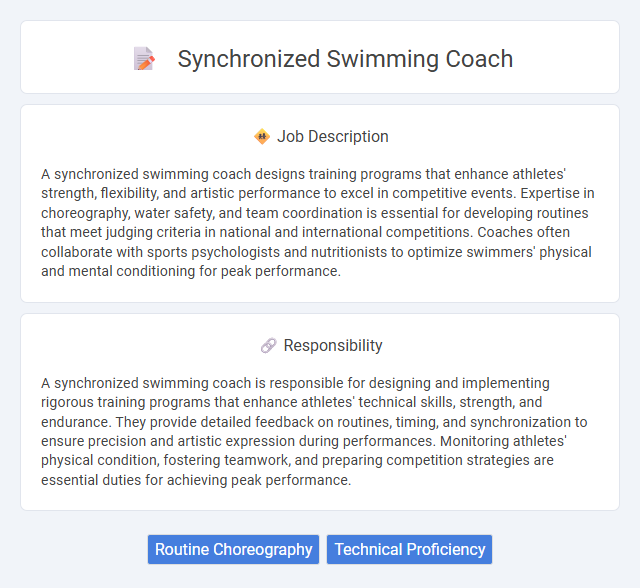
A synchronized swimming coach designs training programs that enhance athletes' strength, flexibility, and artistic performance to excel in competitive events. Expertise in choreography, water safety, and team coordination is essential for developing routines that meet judging criteria in national and international competitions. Coaches often collaborate with sports psychologists and nutritionists to optimize swimmers' physical and mental conditioning for peak performance.
Individuals with strong communication skills and a passion for aquatic sports are likely suitable for a synchronized swimming coach role. Those who possess patience, attention to detail, and the ability to motivate athletes may find this job fulfilling and effective. People who struggle with teamwork or have limited knowledge of swimming techniques might face challenges adapting to the demands of this position.
Qualification
A synchronized swimming coach must possess extensive knowledge in aquatic sports, typically requiring a certification from a recognized swimming or coaching organization such as USA Artistic Swimming or equivalent international bodies. Strong skills in choreography, physical conditioning, and team management are essential to develop athletes' coordination, flexibility, and endurance. Experience in competitive synchronized swimming, along with expertise in injury prevention and sport psychology, enhances coaching effectiveness and athlete performance.
Responsibility
A synchronized swimming coach is responsible for designing and implementing rigorous training programs that enhance athletes' technical skills, strength, and endurance. They provide detailed feedback on routines, timing, and synchronization to ensure precision and artistic expression during performances. Monitoring athletes' physical condition, fostering teamwork, and preparing competition strategies are essential duties for achieving peak performance.
Benefit
A synchronized swimming coach could likely enhance athletes' performance and teamwork through specialized training techniques. The role may offer opportunities for professional growth, networking within the aquatic sports community, and the chance to inspire disciplined, artistic expression in swimmers. Job benefits might also include access to competitive events and potential for travel with teams to regional or national competitions.
Challenge
A synchronized swimming coach likely faces the challenge of balancing technical precision with artistic expression to enhance team performance. Developing synchronized routines that require extensive coordination and timing may demand innovative training techniques and patience. Navigating the physical and mental demands of athletes while fostering teamwork could present ongoing motivational challenges.
Career Advancement
A synchronized swimming coach role offers significant career advancement opportunities through skill development in team leadership, choreography, and sport-specific training techniques. Progression pathways often include moving from assistant to head coach positions and eventually securing roles in national or international teams, enhancing professional reputation. Mastery in athlete development and competitive strategy fosters growth potential within elite sports organizations and academic institutions.
Key Terms
Routine Choreography
A synchronized swimming coach specializing in routine choreography designs intricate and visually captivating aquatic performances that emphasize precision, timing, and artistic expression. They analyze athletes' strengths and flexibility to craft synchronized movements that harmonize with music and accentuate difficulty elements. This role demands deep knowledge of technical regulations, creativity in pattern development, and the ability to inspire swimmers to execute complex sequences flawlessly.
Technical Proficiency
A synchronized swimming coach must demonstrate exceptional technical proficiency in choreographing routines and refining athletes' techniques to enhance performance precision and synchronization. Mastery of breath control, body alignment, and complex aquatic movements is essential for coaching swimmers to execute flawless lifts, spins, and transitions. Expertise in video analysis and biomechanical assessment tools supports continuous improvement and competitive excellence.
 kuljobs.com
kuljobs.com